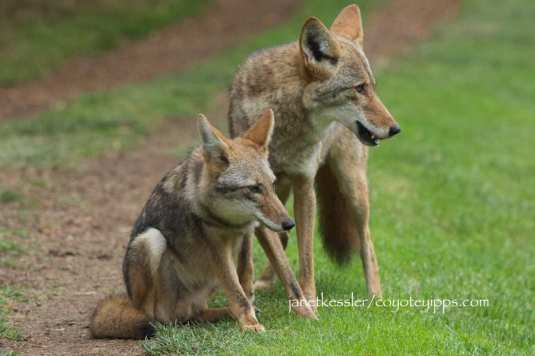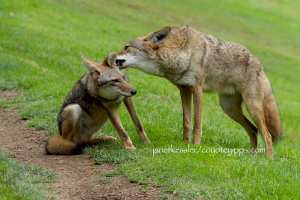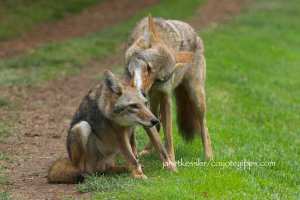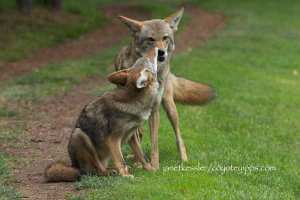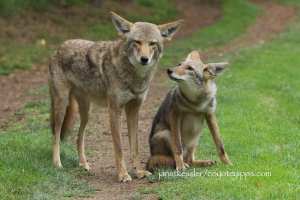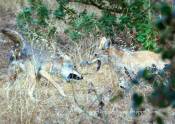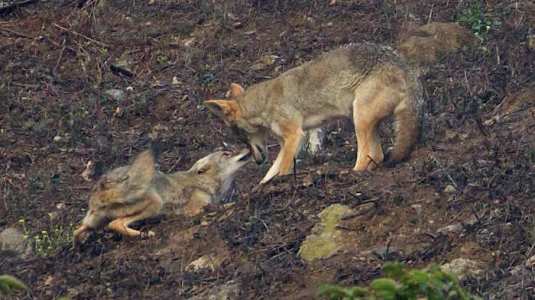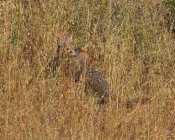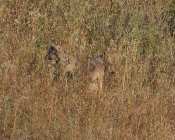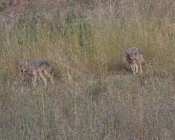

What’s happening in the family Rookie abandoned, and why might he have left?
You’ll recall from my posting that Rookie was actually an unwelcome intruder to begin with within the family he joined and then left. He had moved in on that family which had lost its long-time alpha male to old age, and he moved in right during the short breeding period. The scent of hormones called and he filled that role. But I don’t think Rookie was ever totally accepted. I continued to see the original family grooming each other ever so affectionately — in Rookie’s presence — but he himself, Rookie, appeared to be groomed less often and more out of a sense of duty than anything else.
The remaining yearling male in that family, a two-year-old who might otherwise have been encouraged to disperse, was obviously being encouraged by his mom and remaining sibling to stick around — something I could see through the family’s greetings, grooming and interactions. Well, he’s still there, and with Rookie gone, he appears to be in the process of moving into that alpha male position if he hasn’t already done so.
I get the impression that both Rookie and his abandoned family are happier and better off with the change. Rookie has been warmly and openly accepted by his new mate in a new territory, whereas I don’t think he had ever been totally integrated into the family he left — he always remained “the outsider”. This may be the reason he left. From what I’ve seen in coyote families, interpersonal dynamics and feelings run very much parallel to our own, the big difference being that they seem to move on quickly with the challenges and changes that confront them: with an attitude of, “it is what it is”. And this “abandoned” family is doing just fine — even better — without him. Several generations before this, by the way, within this same family, the family existed and thrived without an alpha male — that male had been killed by rat poison. Over time, one of that alpha’s male offspring ended up moving into that alpha position. This family is quite an inbred one.
How has the abandoned family adjusted to Rookie’s departure? The old alpha female is now the sole overseer and guardian of the family — she had been very much under the thumb of her previous old mate — the one who died of old age — she was always “second” to him in command. But that has now changed. She can be seen guarding and messaging intrusive dogs. Her vigilance keeps her more out in the open, and takes her to knolls with vistas where she perches herself for snoozes, always with one eye open. And she is raising her pups born this year. She still keeps them well hidden, and disciplines them severely for breaking her rules. A couple of days ago I heard intense angry growling, and then the response: the high-pitched complaining yelps of a pup being disciplined. I tried recording it, but did not catch enough of it to post it.
I have not seen the alpha female’s two-year old daughter lately — this is a littermate of the remaining male yearling. Remember that she also and unusually, for being in the same territory, became a mother this year. The last time I saw her she had a horrible huge (6″x 12″) raw, red, inflamed wound on her side. I got the impression it was some kind of mite. I hope she’s healing and I hope she’s still around. I’ll keep my eyes open for her. [UPDATE: Good news! I saw the two-year-old daughter one day after I posted this writeup: she was hunting alone in a field and her hotspot seems to have resolved itself!]




© All information and photos in my postings come from my own original and first-hand documentation work which I am happy to share, with permission and with properly displayed credit: ©janetkessler/coyoteyipps.com.




















